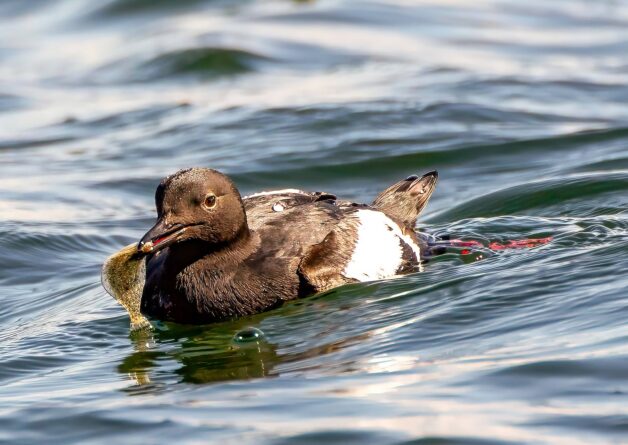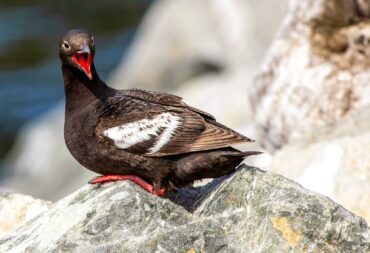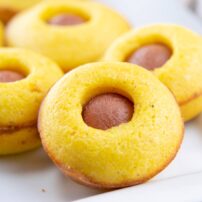
Birds are associated with flight. All but 60 of the world’s 10,000-plus species are capable of flying. Some can only sustain flight for a short distance, while others can glide continuously for weeks. Some birds prefer other forms of transportation to flying. Ground-dwelling quails, rails and roadrunners like to run and tend to fly only short distances to escape predation.
Then there are the aquatic birds, which have a sort of dual existence. They are proficient flyers and adept swimmers. This category includes geese, swans, ducks, grebes and various seabirds such as gulls, terns and alcids. Many of these species can “fly” underwater and through the air.
Alcids, also called auks, are a group of seabirds that include murres, murrelets, puffins, auklets and guillemots. They often nest on seaside cliffs and rock ledges. Although they are not directly related to penguins, they have a similar appearance and are sometimes called the “penguins of the north.” Alcids are well suited for marine life with streamlined football-shaped bodies, short wings and tails, thick waterproof plumage and webbed feet set far back on the body, giving the birds an upright stance on land.
The alcids that breed along Washington’s Pacific Coast and around the Salish Sea are the common murre, marbled murrelet, rhinoceros auklet, pigeon guillemot and tufted puffin. The member of this family that most commonly feeds close to shore is the pigeon guillemot.
A stocky, medium-sized seabird, the pigeon guillemot has a shape and size similar to the rock dove (also called city pigeon). The name “guillemot” derives from the French Guillaume, which translates in English to William.
In breeding plumage, the pigeon guillemot is unmistakable. The black body is contrasted by a prominent white wing patch, easily visible in flight. The legs, feet and inside of the mouth are bright scarlet. Nonbreeders and juveniles sport a combination of white and sooty tones.

The pigeon guillemot inhabits the Pacific Coast and inland waters from Alaska to California. It’s also found along the southeastern shores of Siberia. A year-round resident of the Salish Sea, the pigeon guillemot often feeds in small groups close to shore during the breeding season.
Piles of boulders, like those around ferry terminals, offer ideal habitat for rests between foraging runs. In West Sound, concentrations are greatest in the marine waters around the Hood Canal Bridge, Port Gamble, Hansville, Kingston, Bainbridge Island and Southworth.
Fort Casey Beach on the east side of the Coupeville Ferry Terminal on Whidbey Island is a reliable place to see dozens of pigeon guillemots up close in summer. Birds feed near the shore and rest on the rocks by the boat launch. It gets noisy when multiple guillemots are conversing with sustained high-pitched trills.
Unlike its alcid cousins, which primarily feed far offshore in deep water, the pigeon guillemot prefers inshore shallow water that is usually no more than 30 meters deep. It may feed alongside rhinoceros auklets and common murres in deep water. You can often see individuals and small groups along ferry routes.
A proficient surface diver, the pigeon guillemot propels itself underwater with its wings and steers with its feet. It primarily feeds on small fish, but crabs, worms and mollusks are also on the menu. Prey is captured, often near the seafloor, with a quick jab of the bill.
Unlike puffins that carry multiple fish in their bills, the pigeon guillemot carries only one fish at a time. Foraging near the nest minimizes the commuting distance when feeding nestlings. Flight is just above the water’s surface, up to 50 miles per hour.
The pigeon guillemot reaches maturity between 3 and 5 years of age. It’s a social bird, and multiple monogamous pairs often nest in proximity to one another. Cliffs and rock crevices are ideal spots. Abandoned burrows, holes under tree roots or driftwood, bridges and safe places above the high-tide mark also suffice. The male selects the location and the female lays one or two eggs in a scrape in the ground, which the pair may use for multiple breeding seasons.
Both parents incubate the eggs for about a month. The male defends the nest. The pair cares for the chicks, which leave the nest after four to six weeks. Fledglings can swim and dive immediately but can’t fly for at least a fortnight.
Pigeon guillemot numbers are stable but are known to fluctuate. Because the population is spread out, the risk from localized habitat degradation is lessened, as compared to species with concentrated breeding colonies that can be decimated during disasters such as oil spills.
Summer seabird watching is entertaining. The pigeon guillemot is a spunky, speedy bird in the sea and the air. Look for it from the ferry and on the next trip to the beach.





























